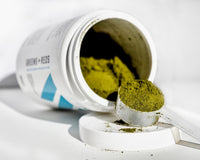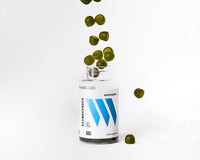Hypertrophy and strength are the two main focal points of resistance exercise. Both are interconnected and complement one another to build muscle size and strength. Resistance training is one of the most beneficial types of training you can do for your body, whether it's built around strength or hypertrophy or bodybuilding. No matter if it's with free weights, body weight, medicine balls, or resistance bands, training under tension is proven to help improve cardiovascular health, reduce injury, increase functional strength, improve mobility, and enhance longevity. We are going to talk more about the differences between strength training vs. hypertrophy training to show you the differences, similarities, and let you know which one you should focus on.
What Is Hypertrophy Training
No matter if you are training to build muscles or gain more strength, it all starts with resistance training. Resistance training or applying repeated physical stress and trauma to your muscle tissue indicates and signals a need to build more muscle and strength to accommodate heavier loads, more workout volume, and increased workout intensity to protect itself from future stress. Muscle hypertrophy refers to an increase in the size of muscle cells and total muscle mass from physical stress. Hypertrophy is often achieved with resistance training and progressive overload to break down and rebuild muscle tissue, resulting in more total muscle mass and bigger gains.
This is the same as bodybuilding. The goal of bodybuilding, is to grow more muscle mass, increasing size. Strength is a positive byproduct, of building bigger stronger muscles. Thus, with bodybuilding and hypertrophy training, you will also stack on more strength.
RELATED ARTICLE What Is Progressive Overload
The human body is comprised of 650 skeletal muscles. Thread-like myofibrils and sarcomeres span across bone and tissue, which can achieve growth, through two ways - muscle stimulation from repeated muscle contraction and muscle repair. The metabolic change for how muscles grow, is an increase in net muscle protein balance, which is simply the difference between muscle protein synthesis (I.e. the muscle building process) and muscle protein breakdown. An increase in net muscle protein balance, is a direct response to resistance training and nutrition which stimulates the anabolic response through muscle protein synthesis, increasing muscle hypertrophy [R].
RELATED ARTICLE How Do Muscles Grow
Muscle growth takes place in two different forms, hypertrophy, and hyperplasia. Hypertrophy is an increase in muscle size due to an increase in the size of muscle fibers, while hyperplasia is an increase in the total number of muscle fibers. Hypertrophy is achieved through increased muscle tension and physical stress, breaking down muscle fiber. Growth is a result from overcompensation to protect the body from future stress, or what we call the repair process [R]. An immune system response is triggered during the repair process leading to inflammation, and the natural cleansing process, signaling the body to grow and repair muscle fiber.
Satellite cells, located on the outer surface of the muscle fibers, facilitate the growth and repair of skeletal muscle tissue, when activated from physical stress or trauma, and resistance training which can last up to 48 hours post workout.
During hypertrophy the rate of muscle protein synthesis is greater than muscle protein breakdown leading to greater numbers of actin and myosin filaments in the myofibrils. Muscle hypertrophy can also occur when muscles are stretched to a greater than normal length. Full range of motion through exercise movements cause new sarcomeres to be added to the ends of muscle fibers where they attach to the tendons. Therefore, exhibiting full range of motion is vital to induce muscle hypertrophy and stack on more gains. Research also indicates that peripheral fatigue, (I.e. burnout sets) induce a greater amount of muscle hypertrophy, as the muscles are worked to failure.
A hormonal response is triggered during hypertrophy, releasing growth factors such as insulin like growth factors, fibroblast, and hepatocyte growth factors. Other hormones are also released which stimulate muscle hypertrophy such as testosterone, cortisol, and human growth hormone, which regulates cell activity and stimulates muscle protein synthesis.
An increase in total workout load or overall volume, progressive overload, or an increase in weight over the course of your training period, and implementing a full range of motion through your lifts, are the key factors for inducing change to muscle tissue and achieving muscle hypertrophy.
RELATED ARTICLE What Is Muscle Hypertrophy
What Is Strength Training
Strength training, a mode or protocol of training, is somewhat synonymous to resistance training. You cannot achieve strength, without increasing lean muscle tissue. You can however focus upon strength, as opposed to muscle hypertrophy.
RELATED ARTICLE How To Get Stronger in 3 Simple Steps
Resistance training program variables such as reps, sets, intensity, tempo, and volume, dictate the outcomes of your training program. Strength and muscle mass are linearly correlated, meaning the more hypertrophic your training, the more strength you’ll gain. Strength is the ability of the nervous system to recruit muscle fibers when needed, to produce initial tension, to overcome an external force. Strength is a neuromuscular adaptation, largely dependent upon the mind muscle connection.
For muscular strength to occur, exertion and stress needs to be placed on the muscle fibers, leading to damage and fatigue. Intensity must be high enough to exert stress, but low enough to finish the rep protocol and allow sufficient reps to exhaustion.
Training for maximal strength occurs with higher levels of intensity, which is inversely related to reps. Thus, the higher level of intensity, the lower number of reps performed.
For maximal strength, research conclusively shows that low reps with heavy weight vs high reps with low weight will elicit the most strength gains. That’s not to say however that strength does not occur with high rep protocols, that prescribe more volume. Intensity is also crucial when it comes to building strength. With less prescribed reps, intensity will need to increase. Resistance exercise intensity is commonly prescribed as a percent of 1 repetition maximum (1RM). Therefore, strength will occur with a prescribed 1-5 reps, at 80-90% of your one rep max (1RM).
RELATED ARTICLE: How Many Reps And Sets For More Muscle And Strength
Strength Training Vs Hypertrophy Training: Reps And Sets
Strength requires heavier loads, with fewer reps, while building more muscle, is focused on overall volume of your workout. Bodybuilding will require a mix of both protocols, meaning higher volume days, and lower rep strength training days.
For example, a leg day workout focused on bodybuilding or hypertrophy could be
Workout |
Reps |
Sets |
| Leg Press | 20 | 4 |
| Bulgarian Split Squat | 15 hard count | 4 |
| Glute Bridge | 15 | 5 |
| Leg Extension | 20 hard count | 6 |
| Deadlifts | 12 | 4 |
Now, an example for strength training would look more like
Workout |
Reps |
Sets |
| Back Squats | 8,6,4,2 | 4 |
| Bulgarian Split Squat | 10,8,6 hard count | 3 |
| Glute Bridge | 10 | 3 |
| Leg Extension | 10,8,8,6 | 4 |
| Deadlifts | 10,8,6,4 | 4 |
As you can tell, there is a significant difference between strength and hypertrophy training, especially when you can see the structured workout protocol, laid out.
Strength training, is really built on executing great form, for slow quality reps, while hypertrophy training is really focused on volume of lifts. Thus, your weight will be much less for bodybuilding and building muscle, compared to going for heavier lifts for strength.
Strength Training Vs Hypertrophy Training: Differences
If you want to achieve different results, then you must modify the variables. Modifications to your training program, or the acute variables, will be key in order to achieve a different training outcome. These variables include
- Training Intensity
- Training Tempo
- Reps
- Sets
- Training Volume
- Rest Intervals
- Training Duration
- Training Frequency
Strength training will require heavier lifts, less reps, more weight, less volume, shorter training duration, and less frequency.
Hypertrophy training requires more sets, more reps, less weight, more volume, increased frequency, faster or moderate training tempo and high intensity.
In my personal opinion, if you're looking to gain strength and build your aesthetic, but you're not quite wanting to be a legit bodybuilder, aim for functional strength, with a mix of strength days and volume. Include heavy squats, with more other accessory isolated movements, for leg day. Then the next week, include a heavy deadlift with the same accessory movements, to build strength and muscle over time.
Strength Training Vs Hypertrophy Training: Takeaway
No matter the focus of your training, resistance training will lead to both muscle hypertrophy and induce changes in muscle strength. They occur simultaneously. However, you can adjust your training to focus on either hypertrophy or strength training.
Hypertrophy training requires more total workout volume, meaning a higher number of sets and reps, to produce a change in muscle size. Strength training will focus upon heavier weight with less reps. Compound lifts such as the bench press, squats, and deadlifts will help build more strength, as they stimulate multiple muscle groups and joints at the same time. This means that you’ll build the greatest amount of strength, in the shortest period of time. Even without heavy weight, compound movements will still help you get stronger, faster, than simply using isolated movements such as bicep curls or exercise machines.
No matter what protocol you focus on, resistance training will help build both hypertrophy and strength.
Need Help With Optimizing Your Diet And Nutrition Plan To Finally Get The Results You've Been Waiting For?
SWOLVERINE IS AN ENDURANCE ATHLETE AND ACTIVE LIFESTYLE BRAND. MADE FOR THE ELITE ATHLETE, AND THE STRONG-WILLED OUR PRODUCTS WERE DESIGNED TO FUEL YOUR ATHLETIC PERFORMANCE. WE PERFORM WHEN YOU PERFORM.
We believe that everyone can optimize not only their athletic performance but their human potential. The way we believe we can optimize performance is through transparency, clinically effective doses, and clinically proven ingredients with evidence-based outcomes. We provide the nutrients you need to power your active lifestyle.
















